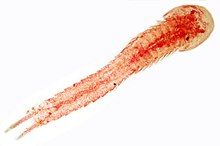Cephalocarida
| Cephalocarida | |
|---|---|

| |
| Hutchinsoniella macracantha | |
| Scientific classification | |
| Kingdom: | |
| Phylum: | |
| Subphylum: | |
| Class: | Cephalocarida
|
| Order: | Brachypoda
|
| Family: | Hutchinsoniellidae Sanders, 1955
|
| Genera | |
| Synonyms | |
| |
Cephalocarida is a class inside the subphylum Crustacea that has only twelve shrimp-like benthic species. They were discovered in 1955, and are commonly referred to as horseshoe shrimps.
All cephalocaridans are in just one family: Hutchinsoniellidae. Even though there is no fossil record of cephalocaridans, most specialists believe them to be basal (primitive) among crustaceans.
Description and anatomy[change | change source]
These crustaceans are from 2 to 4 millimetres (0.079 to 0.157 in) in length, with a long body. They have no eyes, and live in a muddy natural habitat.[1]
The structural and functional similarity between the maxillae and the legs may be a sign of primitive organization; the maxillae are not specialized, as they are in other crustaceans.[1]
The thorax consists of 10 segments, and the abdomen bears a telson but no other appendages.
Ecology[change | change source]
Cephalocaridans are found from the intertidal zone down to a depth of 1500 metres, in all kinds of sediments. They feed on marine detritus. To bring in food particles, they make water currents with the thoracic appendages like the branchiopods and the malacostracans. Food particles are passed forward along a ventral groove, leading to the mouthparts.[2]
References[change | change source]
- ↑ 1.0 1.1 Barnes, Robert D. (1982). Invertebrate Zoology. Philadelphia, PA: Holt-Saunders International. p. 672. ISBN 0-03-056747-5.
- ↑ L.A. Zenkevich. Animal life (Zhizn' Zhivotnykh) vol 2, chapter 7: Phylum Arthropoda.
